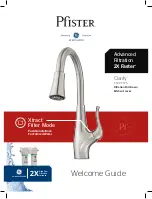
EN
TECHNICAL DATA
Minimum dynamic pressure:______________________________________________________________________0.5 bar
Maximum operational pressure:____________________________________________________________________5 bar
Recommended operational pressure:_____________________________________________________________1-5 bar
It’s recommended to use a pressure reducer in case of
static pressure superior than 5 bar inside the waterpipe.
Maximum hot water temperature:___________________________________________________________________80°C
INSTALLATION, MAINTENANCE AND PRELIMINARY CHECKING PROCEDURE
In
order to get your device work correctly and fi ne in time, must ensure compliance with the mode of instal-
lation and maintenance described in this booklet. Relying on a qualifi ed plumber. Make sure that the system
is free from all debris and impurities existing.
INSTALLATION
Fig. 1:
Make a MIN 60 – 2.36 in, MAX 100 mm – 3.93 in hole into the wall.
N.B.:
MIN and MAX measure are referred to the fi nished wall, cladding included.
Fig. 2:
Insert the body into the hole previously done.
Fig. 3 - 4:
Connect the body to the hydric system by following the arrow printed on it in order to defi ne the
entrance and the exit. It’s recommended to use hemp or PTFE to assure the endurance. Fix the recessed
body taking in consideration the vertical and horizontal perpendicularity. Do it with the help of a spirit level.
Fig. 5:
Make a MIN 60 mm – 2.36 in, MAX 100 mm – 3.93 in hole into the wall.
Fig. 6:
Develop the system by using the entrances and exits indicated on the back of the diverter.
Fig. 7:
Insert the diverter’s body into the hole.
Fig. 8 - 9:
Connect the body to the hydric system. It’s recommended to use hemp or PTFE to assure the
endurance. Fix the recessed body taking in consideration the vertical and horizontal perpendicularity. Do it
with the help of a spirit level.
Fig. 10:
Screw the insert to the hydric system, using hemp or PTFE to ensure the seal.
Fig. 11:
Insert the fi nishing rosette on the spout.
Fig. 12:
Insert the spout on the insert, securing it with the grain. Insert the hole cover.
Fig. 13:
Screw the insert to the hydric system, using hemp or PTFE to ensure the seal. Insert the shower
support on the insert, screw the grain until it is completely blocked.
Fig. 14:
Connect the hose to the outlet support and to the shower hand.
After connecting the body to the system, turn on the stopcocks and check that the mixer tap unit operates
correctly. Keep the tap pressurised for a few minutes checking eventual leaks.
Fig. 15-16:
Reduce the hole in the wall, leaving diameters Ø40mm - 1.57 in both for cold and hot taps and
for the diverter.
Fig. 17:
Screw the fi nishing ring into the taps until it is completely blocked, insert the fi nishing rosette.
Fix the handle on the broach and lock it with the screw.
Fig. 18:
Screw the fi nishing ring on the diverter until it is completely blocked, insert the fi nishing rosette,
Fix the handle on the broach and lock it with the screw.
CLEANING
In order to obtain a correct cleanliness, exclusively wash them with soap and water, rewash and dry them
with a soft towel and deerskin. Avoid the usage of alcohol, solvents, solid or liquid detergents which contain
corrosive or acidic substances, abrasive sponges, swab with metallic strings because they could irreversi-
bly compromise the surfaces.
THE USAGE OF THIS KIND OF DETERGNETS DURING THE CLEANING OF THE MIXER EXCLUDE IB RUBINET-
TERIE FROM ANY WARRANTY OBLIGATION.
Содержание BOLD 398
Страница 1: ...ISTRUZIONI DI MONTAGGIO FITTING INSTRUCTIONS NOTICE DE MONTAGE BOLD 398...
Страница 5: ...Fig 1 Fig 2...
Страница 6: ...Fig 4 Fig 3...
Страница 7: ...Fig 5 Fig 6...
Страница 8: ...Fig 7 Fig 8 Fig 9...
Страница 9: ...Fig 10 Fig 11...
Страница 10: ...Fig 12...
Страница 11: ...Fig 13...
Страница 12: ...Fig 14...
Страница 13: ...Fig 15 Fig 16...
Страница 14: ...Fig 18 Fig 17...
Страница 15: ......
Страница 16: ......


































